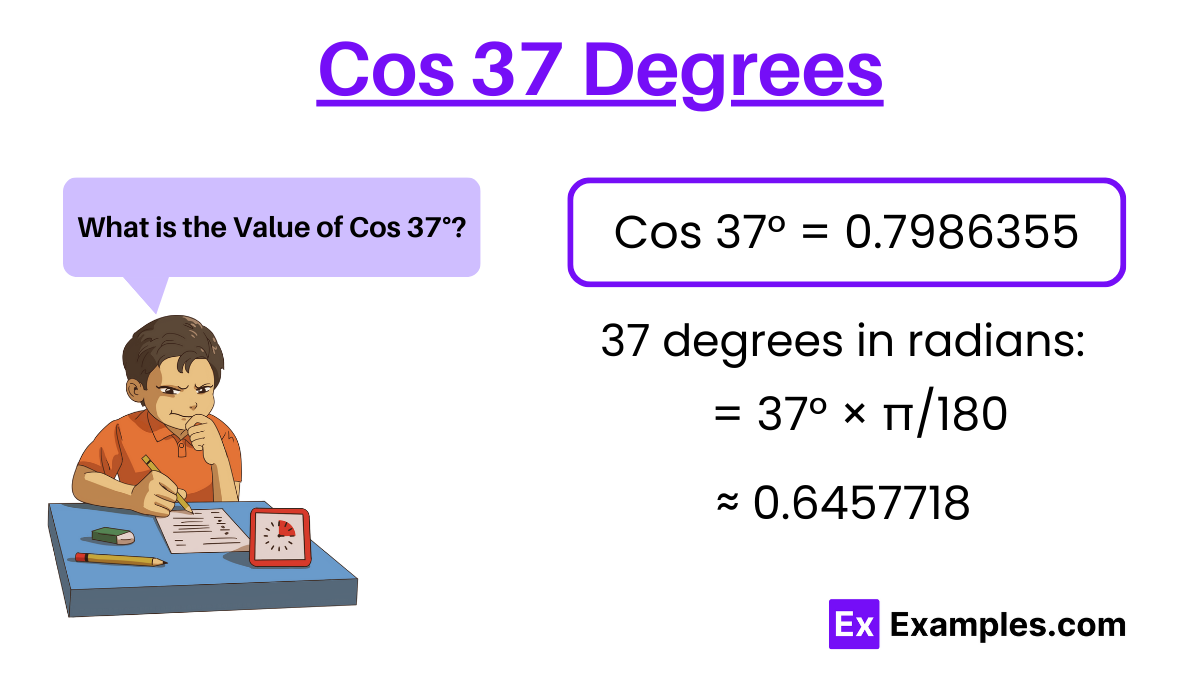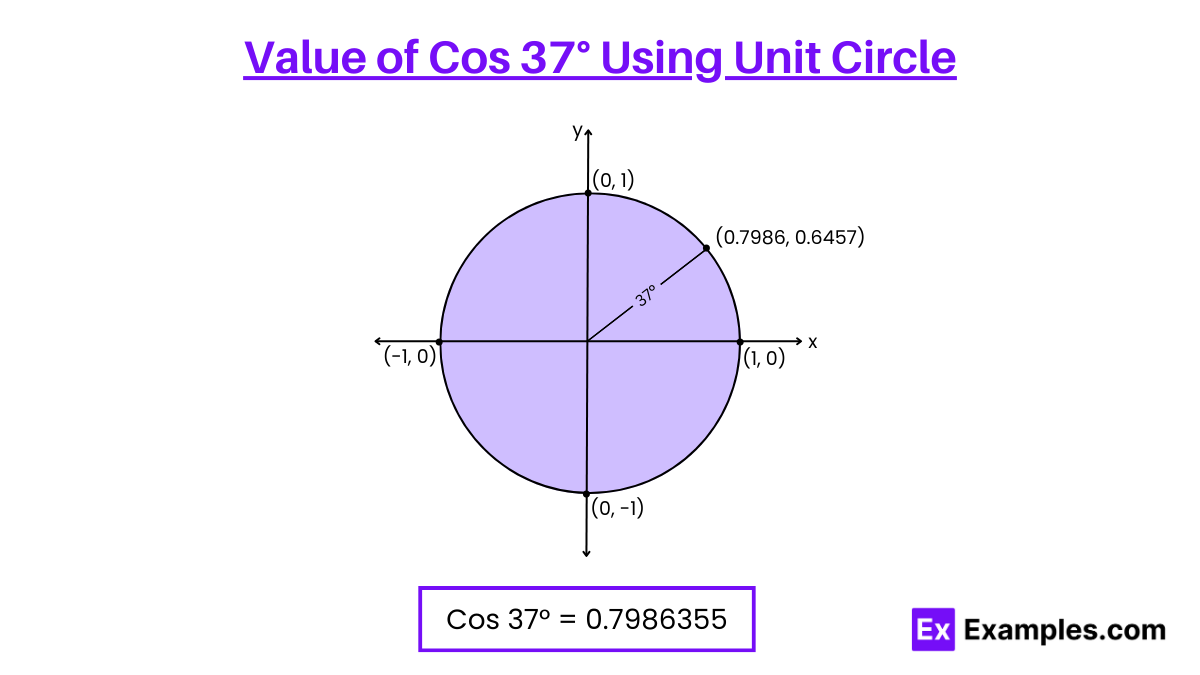What is the approximate value of cos 37°?
0.57
0.60
0.63
0.66


he value of cos 37 degrees is approximately 0.7986355. In radians, cos 37 degrees is written as cos (37° × π/180°), which is cos (0.6457718…). This article will discuss various methods to find the value of cos 37 degrees, with examples.
The cosine of 37 degrees is approximately:
In radians, 37 degrees is converted using the formula: degrees × π/180.
So, in radians:
The Pythagorean identity relates the cosine and sine of an angle.
If sin 37° is approximately 0.6018,
The tangent function can also help in finding the cosine of an angle.
If tan 37° is approximately 0.7536,
Cotangent, another trigonometric function, can be used as follows:
If cot 37° is approximately 1.327,
Cosecant provides another way to express cos 37 degrees:
If cosec 37° is approximately 1.6629,
Finally, secant, the reciprocal of cosine, gives us a direct formula:
If sec 37° is approximately 1.251,
Cos 37 degrees can be related to other angles using complementary and supplementary angle identities:
Given that sin 37° is approximately 0.6018, we can find cos 37°:

Problem 1: Verify Cos 37° using the Pythagorean identity
Solution:
We know that:
Sin 37° = 3/5
Using the Pythagorean identity:
Cos² 37° + Sin² 37° = 1
Substitute Sin 37°:
Cos² 37° + (3/5)² = 1
Cos² 37° + 9/25 = 1
Cos² 37° = 1 – 9/25
Cos² 37° = 25/25 – 9/25
Cos² 37° = 16/25
Cos 37° = 4/5
Problem 2: Use Cos 37° to find Sin 53°
Solution:
We know that:
Sin 53° = Cos (90° – 53°) = Cos 37°
Since we already know:
Cos 37° = 4/5
Therefore:
Sin 53° = 4/5
Problem 3: Calculate the value of 2Cos² 37° – 1
Solution:
First, calculate Cos² 37°:
Cos 37° = 4/5
Cos² 37° = (4/5)² = 16/25
Then, use the expression:
2Cos² 37° – 1 = 2 × 16/25 – 1
2Cos² 37° – 1 = 32/25 – 1
2Cos² 37° – 1 = 32/25 – 25/25
2Cos² 37° – 1 = 7/25
Problem 4: Find Cos 37° given Tan 37°
Solution:
We know:
Tan 37° = 3/4
Using the identity:
Tan x = Sin x / Cos x
Tan 37° = (3/5) / Cos 37°
We already know:
Cos 37° = 4/5
Problem 5: Use Cos 37° to find Cos 74°
Solution:
We know that:
Cos 74° = Cos (2 × 37°)
Using the double-angle identity:
Cos 2x = 2Cos² x – 1
Cos 74° = 2Cos² 37° – 1
We already calculated:
Cos² 37° = 16/25
So:
Cos 74° = 2 × 16/25 – 1
Cos 74° = 32/25 – 1
Cos 74° = 32/25 – 25/25
Cos 74° = 7/25
Cos 74° = 7/25
The value of cos 37 degrees is approximately 4/5, but more accurately, it is 0.7986, which is close to the fraction 4/5.
The value of sin 37 degrees is approximately 0.6018, often memorized in trigonometry for quick reference.
The magnitude of cos 37 degrees is 0.7986, representing its absolute value, which is always positive.
Sin 37 degrees can be expressed using cosine as sin 37° = cos 53°, based on complementary angles.
Remember sin 37 degrees as approximately 0.6, part of the commonly used sin-cosine pair: sin 37° ≈ 0.6 and cos 37° ≈ 0.8.
Text prompt
Add Tone
10 Examples of Public speaking
20 Examples of Gas lighting
What is the approximate value of cos 37°?
0.57
0.60
0.63
0.66
If cos 37° = x, what is the value of x?
0.63
0.65
0.66
0.67
Which of the following is closest to the value of cos 37°?
0.70
0.64
0.66
0.68
What is the value of cos 37° in terms of its approximate decimal form?
0.61
0.65
0.66
0.67
How does the value of cos 37° compare to cos 30°?
Cos 37° is smaller than cos 30°
Cos 37° is equal to cos 30°
Cos 37° is larger than cos 30°
Cos 37° is approximately the same as cos 30°
If the cosine of an angle is 0.66, what is the angle in degrees?
37°
30°
45°
60°
What is cos 37° if expressed as a fraction?
2/3
1/2
3/4
1/3
What is the exact value of cos 37° in radians?
0.66 radians
0.645 radians
0.6455 radians
0.66 radians
How does cos 37° relate to the cosine of 45°?
Cos 37° is greater than cos 45°
Cos 37° is less than cos 45°
Cos 37° is equal to cos 45°
Cos 37° and cos 45° are approximately the same
What is the cosine value of 37° when rounded to two decimal places?
0.65
0.66
0.67
0.68
Before you leave, take our quick quiz to enhance your learning!

